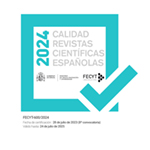Keeping the difference. The translation of English/Spanish code-switching in Latino literature: a case study
Abstract
This paper analyses a novel belonging to the so-called “Latino literature”, with English/Spanish code-switching as its main linguistic feature. The aim is to study the strategies that have been used both by the author and the translator. In the first case, we find similar strategies to those applied by other writers (self-translation, the insertion of symbols of the Spanish language…); in the second case, a predominant use of the compensation technique is detected. By analyzing contextualized examples, this translation technique is determined to be one of the most effective ways to translate texts in which this language interchange is a main characteristic. The importance of maintaining this feature in translations, not only from a linguistic point of view, but also as a way to portray a social context, is also emphasized.
Downloads
Article download
License
In order to support the global exchange of knowledge, the journal Estudios de Traducción is allowing unrestricted access to its content as from its publication in this electronic edition, and as such it is an open-access journal. The originals published in this journal are the property of the Complutense University of Madrid and any reproduction thereof in full or in part must cite the source. All content is distributed under a Creative Commons Attribution 4.0 use and distribution licence (CC BY 4.0). This circumstance must be expressly stated in these terms where necessary. You can view the summary and the complete legal text of the licence.









